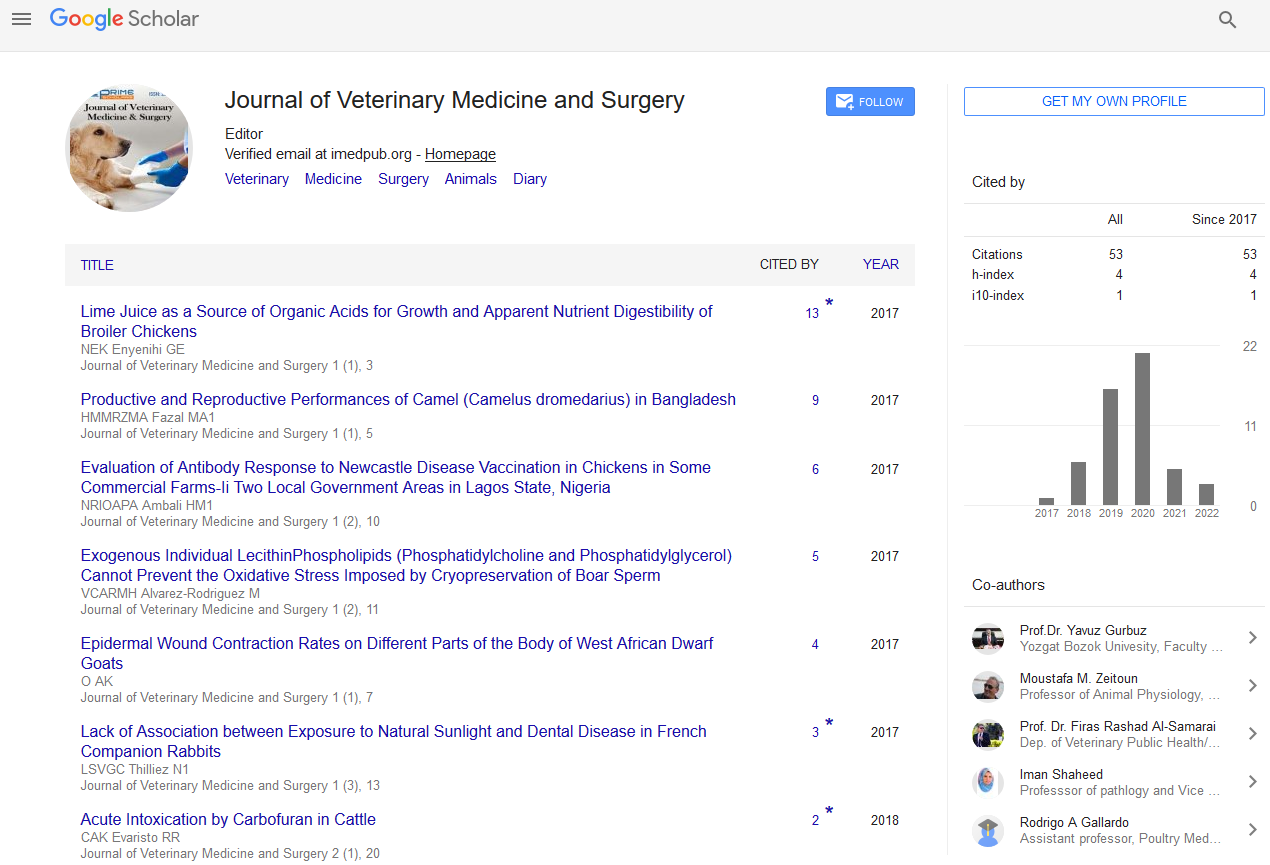Short Communication - (2024) Volume 8, Issue 1
Recognising Animal Gastropexy: A Complete Overview
Abigale Rene*
Department of Veterinary Science, Yale University, USA
*Correspondence:
Abigale Rene,
Department of Veterinary Science, Yale University,
USA,
Email:
Received: 28-Feb-2024, Manuscript No. IPJVMS-24-19434;
Editor assigned: 01-Mar-2024, Pre QC No. IPJVMS-24-19434 (PQ);
Reviewed: 15-Mar-2024, QC No. IPJVMS-24-19434;
Revised: 20-Mar-2024, Manuscript No. IPJVMS-24-19434 (R);
Published:
27-Mar-2024, DOI: 10.36648/2574-2868.8.1.02
Introduction
The incision can be performed at various locations, and the
choice depends on the surgeon’s preference and the specific
circumstances of the patient. A belt-loop gastropexy involves
creating a “belt” from a portion of the stomach wall and
securing it to the abdominal wall. This technique provides
additional anchoring and stability. Tube gastropexy involves
placing a tube, such as an orogastric tube, through the body
wall and suturing it to the stomach. This technique combines
gastropexy with gastric decompression. Endoscopic procedures
offer a minimally invasive approach, involving the use of an
endoscope to guide the placement of sutures between the
stomach and abdominal wall. After gastropexy surgery, diligent
postoperative care is essential to ensure a smooth recovery
and minimize complications. Monitoring the patient closely
for any signs of discomfort, infection, or complications is
crucial. Postoperative care considerations include: Adequate
pain management is essential for the comfort and well-being
of the animal. Veterinarians may prescribe pain medications
to alleviate postoperative discomfort. Continuous monitoring
of vital signs, including heart rate, respiratory rate, and
temperature, helps detect any signs of distress or complications
early on.
Description
Restricting the animal’s activity during the initial recovery
period is crucial to prevent strain on the surgical site. This may
involve limiting exercise, avoiding jumping, and ensuring a
calm and controlled environment. Gradual reintroduction of a
carefully monitored and easily digestible diet is essential. This
may involve starting with small, frequent meals to allow the
gastrointestinal tract to adapt. Regular follow-up examinations
with the veterinarian are critical to assess the healing progress,
address any concerns, and ensure the long-term success of
the gastropexy. Beyond the immediate benefits of preventing
GDV, gastropexy has broader implications for animal health
and welfare. By addressing the genetic predisposition and
susceptibility to GDV in certain breeds, gastropexy contributes
to the overall well-being of these animals. Additionally, the
procedure can alleviate the emotional and financial burden
on pet owners who would otherwise face the challenges of
managing and treating a potentially fatal condition. While
gastropexy is a highly effective preventive measure against GDV,
it is not without challenges and considerations. Some of these
include: Any surgical procedure involves the administration of
anesthesia, which carries inherent risks. Veterinarians must
carefully assess the patient’s overall health and suitability for
anesthesia. Gastropexy is an invasive surgical procedure that
requires careful consideration of the patient’s age, health
status, and potential complications associated with surgery.
Not all breeds are equally susceptible to GDV [1-4].
Conclusion
Performing gastropexy on breeds with low predisposition may
be unnecessary and pose additional risks without significant
benefits. Some owners may opt for alternative preventive
measures, such as dietary management, elevated feeding,
and lifestyle modifications. Veterinarians should discuss
these options with pet owners to make informed decisions.
Gastropexy stands as a critical intervention in the prevention
of GDV, a life-threatening condition that predominantly affects
large and deep-chested dog breeds. By securing the stomach
to the abdominal wall, gastropexy mitigates the risk of gastric
torsion, providing a lifeline for at-risk animals. Understanding
the anatomy, pathophysiology, and surgical techniques involved
in gastropexy is paramount for veterinarians, pet owners, and
animal enthusiasts alike.
Acknowledgement
None.
Conflict Of Interest
None.
References
- Allen P, Paul A (2014) Gastropexy for prevention of gastric dilatation-volvulus in dogs: History and techniques. Top Companion Anim Med 29(3):77-80.
[Crossref] [Google Scholar] [PubMed]
- Freeman LJ (2009) Gastrointestinal laparoscopy in small animals. Vet Clin North Am Small Anim Pract 39(5):903-924.
[Crossref] [Google Scholar] [PubMed]
- Ellison GW, Case JB, Regier PJ (2019) Intestinal surgery in small animals: Historical foundations, current thinking, and future horizons. Vet Surg 48(7):1171-1180.
[Crossref] [Google Scholar] [PubMed]
- Rawlings CA (2002) Laparoscopic-assisted gastropexy. J Am Anim Hosp Assoc 38(1):15-19.
[Crossref] [Google Scholar] [PubMed]
Citation: Rene A (2024) Recognising Animal Gastropexy: A Complete Overview. J Veterinary Med. 8:02.
Copyright: © 2024 Rene A. This is an open-access article distributed under the terms of the Creative Commons Attribution License, which permits unrestricted use, distribution, and reproduction in any medium, provided the original author and source are credited.

